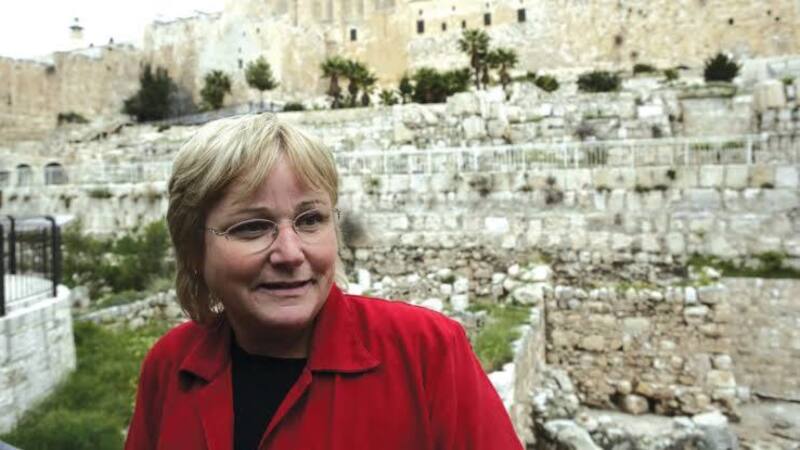
IT IS WRITTEN!
The amazing story of Eilat Mazar’s discovery and of her persistent belief in what ‘is written’ in the Bible!
It was kind of frozen in time IN THE PAGES OF SCRIPTURE!
Mazar:
“It was amazing, unexpected, and I thought, Oh, wow, so much gold. What am I going to do for 1000s of years, Jerusalem has been a city wrapped in stone and mystery
Beneath its narrow streets and ancient walls lie layers of history, each one stacked upon the other like chapters in a book no-one has finished reading.
At its heart is the city of David, the small ridge where the story of Israel's greatest King was to begin.”
“The Bible tells us that King David conquered this fortress, turned it into his Capital and built a palace that stood as the seat of his power. But for centuries, archeologists argued, was this real history or just a legend told to inspire scattered people, dig after dig yielded fragments, walls, pottery, tunnels, but no palace. Scholars concluded David was little more than a tribal chief his so called ‘Kingdom’ - a glorified village.”
And then came Dr Eilat Mazar, born into a dynasty of archeologists, she defied academic convention, where others dismissed the Bible as myth. She read it as a map. Her quest was not just to find artifacts, it was to prove the stories written in Scripture had flesh, blood and stone behind them.
Before her sad death at only 64, from an unspecified illness in 2021, she made a confession that she believed she had found the remains of King David's Palace, massive walls! Clay seals bearing names straight out of Scripture and a fortress that matched the Bible's description.
To some, she was a visionary.
To others, a dreamer Chasing Shadows
But what she revealed may be the closest we have ever come to uncovering the truth.
Because Eilat Mazar, whose story begins long before she ever picked up a trowel, was a true visionary, whose integrity was based on the infallible integrity of God’s word and it was as unshakeable as God’s word as well.
Born in Jerusalem in 1956 she grew up surrounded by history, not just in the landscape of her city, but at her own family's dinner table.
Her grandfather, Benjamin Mazar, one of Israel's most respected archeologists, was credited with groundbreaking excavations near the temple mount.
His work shaped the very foundation of modern Israeli archeology. For Eilat Mazar, history was never just dates and ruins. It was family tradition.
From an early age, she showed an unusual fascination with the Bible.
While most children read the stories of David and Goliath or Solomon's temple as fables, Eilat absorbed them as historical facts waiting to be proven. She saw in them not just lessons of faith, but clues, geographical hints, architectural details and narrative breadcrumbs that might lead to real places buried beneath her city.
By the time she was a student, it was clear she would follow the same path as her grandfather, yet she also stood apart in the academic world.
Relying on the Bible to guide excavations was controversial. Many scholars insisted that archeology should be independent, guided by physical evidence alone. To them, biblical archeology was a tainted phrase, a practice too easily, colored by faith and politics.
Eilat disagreed.
She believed the Bible was not merely spiritual literature, but a historical document, no different from Egyptian inscriptions or Assyrian tablets. To ignore it, she argued, was to throw away one of the most valuable records of the ancient Near East. Her conviction gave her both admirers and enemies in lecture halls, she was often dismissed as naive. Colleagues muttered that she was chasing legends, but in the field, shovel in hand, she was relentless, for her archeology was not just a career. It was a mission to bridge the gap between scripture and stone.
Eilat Mazar in the foreground aged 54
That mission narrowed to one figure, King David, to Eilat, proving David's kingdom was real meant proving that the Bible's grand narratives were rooted in history, not myth.
She wasn't looking for small finds. She wanted the palace, the beating heart of David's reign. If she could uncover that, it would be one of the most significant archeological discoveries of the modern age. Others had tried and failed, but Eilat had something they lacked, the infallibility that the Bible itself held.
To understand Mazar's search, you have to understand the place she focused on, the city of David.
Today, it is a narrow Ridge just south of Jerusalem's old city, overshadowed by the gleaming dome of the rock and the walls built centuries later by Ottoman Sultans, but in David's time, around the 10th century BC, this ridge was Jerusalem, according to Scripture, it was originally a Jebusite stronghold, thought to be impregnable, the locals mocked David and his men, boasting that even the blind and the lame could defend it.
But the Israelites found a weakness, a water shaft that led from the Gihon Spring into the city.
By sneaking through this lifeline, David's men captured the fortress.
From that day, it was known as the City of David, and from its heights, a Kingdom began to spread.
For archeologists, the city of David has always been a magnet.
In the 19th century, British explorer Charles Warren tunneled through its bedrock, mapping out the ancient water system and identifying what became known as Warren's shaft. His discoveries gave the first glimpse of how old Jerusalem really was. A century later, Kathleen Kenyon. (No relation to E W Kenyon, Kathleen Kenyon was not related to E. W. Kenyon; Kathleen Kenyon was the daughter of Sir Frederic Kenyon, a scholar and former director of the British Museum, with her family tree documented to Lloyd Kenyon, 1st Baron Kenyon. There is no record or indication of a family connection to E. W. Kenyon, a prominent American biblical scholar and author of religious books.)
One of the most renowned archeologists of her time, Kathleen dug into the same ridge. And her conclusion was devastating for biblical literalists. She argued, Jerusalem, in David's time, was nothing more than a small hill village, no palace, no grand kingdom, just a modest settlement. Benjamin Mazar Mazar Eilat’s grandfather, also excavated in Jerusalem, but he focused his efforts closer to the Temple Mount. He revealed remarkable finds, but never uncovered the palace. By the early 2000s the academic consensus was clear, if David existed at all, he was a minor chieftain. The glorious Empire described in the Bible was an exaggeration, written centuries later, the palace was a myth, but Eilat Mazar refused to accept that. She believed the problem wasn't that David's Palace didn't exist. It was that archeologists had been looking in the wrong place.
Yes, the Bible says God's word is established forever in verses like Psalm 119:89, "Forever, O LORD, Your word is established in heaven", and in Isaiah 40:8, "The grass withers and the flowers fall, but the word of our God endures forever". Jesus also affirmed this in Matthew 5:18 and Matthew 24:35, stating that "Heaven and earth will pass away, but my words will never pass away".
But Psalm 14:1 says Only fools say in their hearts, “There is no God.” They are corrupt, and their actions are evil; not one of them does good!
To her, the answer was hidden in plain sight, buried in the very ridge where the story began.
The City of David still held its secrets, and she was determined to uncover them.
For years, archeologists combed the city of David without finding a royal palace. Theories collapsed, digs stalled, and many gave up, but Eilat Mazar believed everyone was overlooking the obvious. Her Guiding Light was not an inscription, not a shard of pottery, but a single verse from the Bible in the second book of Samuel, chapter five, verse 11, it reads, 2 Samuel 5:11–12 how the king of Tyre, Hiram, sent cedar trees, carpenters, and stonemasons to David to build him a house (a palace). The passage also states that David "knew that the LORD had established him as King over Israel" and had "exalted his kingdom for His people Israel's sake," indicating David's recognition of God's hand in his successful reign and the strengthening of his kingdom.
To Mazar this wasn't just poetic flourish. It was a blueprint. The verse revealed three important details. First, that David's Palace was constructed with cedar wood, a Phoenician luxury material not native to Israel. Second, skilled foreign craftsmen were involved, meaning the building was of monumental scale. And third, that the palace was considered important enough to record in Israel's central historical text. If Tyrion builders came to Jerusalem, they would not have built a hut on a village hilltop. They would have constructed a monumental residence fit for royalty.
That single verse convinced Mazar that David's Palace must have been both real and extraordinary.
Her next question was location, where in the city of David would such a building stand for her, the answer was clear on the highest and most defensible point overlooking the city. Below that place was the ophel,
Is a Ophel Biblical Term
Meaning:
A fortified hill or a higher, prominent area within a city.
Context:
The term is used in the Hebrew Bible to refer to a specific part of Jerusalem and Samaria)
The elevated ridge that connected the city of David to the Temple Mount. On that ridge stood the stepped stone structure, a massive man made terrace of stones stacked into a hillside. Archeologists had long debated its purpose. Some said it was just a retaining wall. Others believed it was part of a fortress. But in the Bible, there is a reference to the Millo, a great supporting structure that David and Solomon fortified.
To Mazar, the stepped stone structure, and the biblical Millo were one and the same, and if that were true, then the palace would have been built directly above it. Her colleagues dismissed the idea. They warned her she was leaning too heavily on the Bible, allowing faith to cloud judgment. But Eilat saw it differently. If we treat the Bible like any other historical document, she once argued, it can guide us to where the stones are buried.
In 2005 she decided to put her theory to the test. She applied for permission to dig at the top of the stepped stone structure. Many in the archeological community watched with skepticism, some even with amusement. Could she really find David's Palace based on one verse of scripture?
Eilat Mazar didn't care what they thought. She had her location, she had her team, and she had her conviction. The City of David was about to reveal its secrets. Summer in Jerusalem can be brutal. The air hangs dry, the sun scorches the hills and the stones themselves radiate heat like ovens. But in 2005 none of that mattered to Eilat Mazar and her team as they broke ground on their most ambitious dig yet, they set up camp on the northern edge of the city of David, just above the great terrace of stones that had puzzled archeologists for over a century. Mazar believed she was standing on the doorstep of King David's palace. Others scoffed, but she pressed forward. The work was painstaking. Layers of dust. Rubble, and centuries of collapsed houses had to be cleared away. Every stone was cataloged, every fragment of pottery carefully brushed and bagged. Archeology, despite its romantic image, is slow and exhausting work. Progress came bucket by bucket, and then, as the days turned into weeks, something unexpected began to appear beneath the debris, the team uncovered walls, thick walls, not the kind used for common houses, but walls made from massive, well cut stones. They stretched deep into the hillside, forming the outline of a structure unlike anything ordinary. Even more telling was the pottery they found buried in the soil layers alongside the walls. Archeologists often date ruins by pottery, because styles changed over the centuries. The fragments discovered here match the period of the Iron Age around the 10th century BC, the era traditionally associated with King David.
This was no shepherd's village! Whoever had built these walls had resources, power and access to skilled craftsmen. Still, Mazar knew caution was essential. A grand building alone wasn't proof of David's palace. Jerusalem had been occupied and rebuilt countless times over the centuries. These walls could belong to a later king or perhaps to a fortress or administrative center, but she felt certain she was closing in on something monumental. The deeper they dug, the larger the structure appeared, and beneath every layer of soil, the story of Jerusalem seemed to whisper back at her, ‘keep going.’
The world of archeology was watching closely, many hoping to see her fail, but what she unearthed next would silence even her harshest critics, as excavation continued, the scale of the discovery grew. The walls weren't just thick, they were massive. Built from enormous, dressed stones, carefully carved and fitted together. Some weighed several tons. This was not the architecture of a village. This was the work of a powerful kingdom. The layout revealed the footprint of a monumental building, far larger than anything previously uncovered from this period in Jerusalem, there were signs of a gatehouse and what may have been a defensive tower. The structure dominated the landscape commanding the ridge above the city of David. Mazar called it the large stone structure, but to her, it was more than just large. It was royal, the craftsmanship, the size and the strategic location all pointed to a building of immense importance. For the first time, the possibility of a real Davidic Palace was no longer a fantasy. This was the kind of structure described in Second Samuel, a palace fit for a king. Pottery fragments provided critical dating evidence, many belonged to the Iron Age, to a which scholars place around the 10th century BC. That was precisely the time when David and Solomon would have ruled. Even skeptics admitted the discovery was extraordinary, but the true weight of the find lay in what it implied, if Jerusalem had buildings of this scale in the 10th century. Then it wasn't a mere hilltop village, it was a political and administrative center, the capital of a kingdom that directly challenged the dominant scholarly view that David's reign was a myth or a minor tribal chiefdom exaggerated by later writers. Still the debate raged. Could this really be David's Palace, or was it another important building from a later time? Critics were quick to point out that without an inscription, the connection remained speculative, but Mazar wasn't done because, just as the walls were impressive, the ground around them held something even more compelling, objects, small enough to fit in the palm of a hand, but powerful enough to shake the world of archeology.
They were seals bully pressed with the names of figures pulled straight from the Bible, and with them, the line between scripture and history began to blur.
For centuries Archeologists puzzled over the massive stepped stone structure rising like a giant staircase on the slope of the City of David. It seemed less like a building than a colossal retaining wall designed to support the ridge above. But to Mazar, this feature was not just an engineering marvel. It was the biblical Millo, the Hebrew word Millo means fill, and the Bible records that both David and Solomon fortified it in Second Samuel five, verse nine. It reads ‘So David dwelt in the fort and called it the city of David. And David built round about from the millow inward.’
Most scholars considered the term too vague to identify - to Mazar, however, the description matched perfectly. The stepped stone structure was a massive fill of stones, precisely the kind of rampart the verse described. And crucially, the large stone structure, the building she believed to be David's palace was built directly on top of it.
This changed everything, if her interpretation was right, the two structures were not separate mysteries, but parts of one grand complex, the fortress and palace of King David. Strategically, it made sense, the Millo created a fortified base that stabilized the slope, while the palace at its summit commanded the highest point of the city. Anyone entering Jerusalem would have seen it looming above them, a visible symbol of royal power. Militarily, it made the king's residence almost untouchable. Politically, it placed him at the literal center of his capital. Her colleagues remained skeptical. Some said the Millo could have been a support for houses or terraces, nothing more. Others argued it dated later to the time of the Judean kings. But for Mazar, the pieces fit too perfectly to ignore. The palace was not an isolated building. It was part of a larger defensive and administrative system, the very system described in the Bible, if true, meant David's palace had not just been found. It had been hiding in plain sight all along, sitting atop the fortress that bore his name. The discoveries electrified the public, headlines declared that David's palace had been found.
Here’s what Wikipedia says about the Millo
The Millo (Hebrew: המלוא, romanized: ha-millō) was a structure in Jerusalem referred to in the Hebrew Bible, first mentioned as being part of the city of David in 2 Samuel 5:9 and the corresponding passage in the Books of Kings (1 Kings 9:15) and later in the Books of Chronicles (1 Chronicles 11:8). However it previously seems to have been a rampart built by the Jebusites prior to Jerusalem's being conquered by the Israelites.[1] The texts also describe the Millo built by Solomon[2] and repaired by Hezekiah,[3] without giving an explanation of what exactly the Millo was: there is therefore some debate among scholars as to the Millo's specific nature. The most common assumption among archaeologists and historians of ancient Israel is that the Millo is the Stepped Stone Structure uncovered by Kathleen Kenyon and demonstrated by Eilat Mazar to be connected to a Large Stone Structure which she discovered in 2005.
Tours to the city of David's site surged. Visitors marveled at the towering stones and imagined the biblical King walking the same ground. But in academia, the response was anything but unanimous. Skeptics pointed out that the large stone structure could have been anything, a fortress, a storehouse, even an administrative building without an inscription saying, this is the palace of King David. The claim remained speculative. Some argued the dating was off. They insisted Jerusalem did not reach monumental scale until the ninth or even eighth century, BC, later than David's supposed reign. From their perspective, the pottery evidence could just as easily fit those later centuries. Others suggested the building might have belonged to a different King entirely, perhaps one of David's descendants. Yes, it was grand. Yes, it was early, but was it David's? That was the LEAP they refused to make.
Critics noted that the seals of Hezekiah, Gedaliah and Jehu Kal belonged to the seventh and eighth centuries, BC, not the 10th. They proved the site was used later, but not that David himself had lived there. Mazar countered each criticism with conviction. The pottery styles, the stratigraphy and the sheer scale of the structure pointed to the 10th century, the later seals, she argued simply showed the building's continuous use across generations. That was exactly what one would expect from a royal palace, rebuilt, reused and occupied for centuries, the debate grew fierce.
On one side were biblical archeologists and scholars willing to see the Bible as history.
On the other were revisionists who argued the stories of David and Solomon were written centuries later and inflated into myths. Mazar’s work forced a shift in the conversation. The question was, no longer, did David exist, but how powerful was he? To her supporters, the discovery was groundbreaking.
To her critics. It was a dangerous overreach.
To the public. It was thrilling, a tangible connection to one of history's most legendary kings.
And to Mazar herself. It was vindication, by 2010 a lot of vindicatio.
Mazar had already shaken the archeological world with her claims about the palace, but she wasn't finished. She shifted her team's focus slightly north to the ofel, the ridge linking the city of David to the Temple Mount. There, she uncovered yet another piece of the puzzle, a massive fortification wall. The wall was no ordinary barrier. Its stones were enormous, stacked with precision into a line that stretched across the hillside.
Alongside it, her team found the ruins of a royal gatehouse. These were not defensive structures for a village. They were monumental works of architecture, the kind that could only be built by a centralized, powerful government.
Once again, pottery provided the key to dating the shards buried within the foundation layers were from the Iron Age, specifically the 10th century BC, the time of David and Solomon to Mazar.
The implications were staggering. If Jerusalem had such walls and gates in the 10th century, then it was not a modest outpost, it was a fortified capital exactly as the Bible described. The discovery gave weight to the argument that Jerusalem had been a major city during the United monarchy. To critics, it was more evidence to wrestle with, even if they remained unconvinced about the palace itself. But to Mazar, the wall and the palace were part of the same story, a city transformed from a Canaanite stronghold into the capital of a kingdom. Standing before the massive stones. She felt vindicated. The City of David was revealing itself not as legend, but as living history, for Mazar, the search for David's city was never just about walls and palaces. It was also about strategy, how ancient kings made Jerusalem not only powerful but survivable. That meant water. The Gihon Spring was Jerusalem's only natural water source in the 10th century, BC, whoever controlled it controlled the city. According to the Bible, David captured Jerusalem through its water system. Second Samuel five eight records that Joab David's general entered the city through the water shaft. For decades, scholars doubted this. 19th century explorer Charles Warren had discovered a vertical shaft near the Gihon later named Warren's shaft, but it seemed too narrow and impractical for soldiers to climb. Critics concluded the story was legendary. Mazar revisited the evidence in her final years, she argued that the so called fortress of Zion was not just a single wall or tower, but the entire fortified system around the Gihon Spring. Protecting the spring would have been Jerusalem's top priority, and it explained why David's men would target it. Her interpretation reframed the story. David didn't need to scale an impossible shaft. He needed only to seize the defenses of the water system, cutting off the city's lifeline. In that moment, the impregnable Jebusite fortress became his.
This insight tied the archeology to the biblical narrative. Once again, it wasn't just about grand palaces, but about practical survival and military strategy. To Mazar, it was yet another sign that the Bible stories were rooted in real events anchored in the stones of Jerusalem.
When Dr Eilat Mazar passed away in 2021 she left behind more than just excavation reports and academic debates. She left behind a vision of Jerusalem, where faith and history intertwined, where the words of Scripture rose from the dust in stone walls, Clay seals and fortified terraces, her discoveries - the large stone structure, the bully bearing names from the Bible, the massive city wall, and her reinterpretation of the water system, ignited a debate that still rages today, did she truly find the palace of King David? Skeptics argue the evidence is circumstantial, that the structure could have been a fortress or an administrative building. Supporters point to the scale the pottery and the biblical connections as proof that David's Jerusalem was real, powerful and monumental. What cannot be denied is that Eilat Mazar changed the conversation before her. Many scholars dismissed David as little more than a myth, after her the question was, no longer, did David exist, but how powerful was he? In the end, perhaps we will never find a stone carved with the words, “this is the palace of King David”. Archeology rarely gives us certainties that are neat, but what Mazar uncovered brings us closer than anyone else has.
Because her final confession was not a claim of absolute proof, but a statement of conviction. She believed she had found the heart of David's Jerusalem, and in that belief, she reminded the world that sometimes the stories we call legends are built on stones that still lie beneath our feet. The City of David remains a place of mystery. Its secrets buried deep, but thanks to Eilat Mazar, we now know that within those stones, the echoes of an ancient kingdom still whisper. So what do you think, did Eilat Mazar uncover King David's Palace, or are the stones keeping their secret a little longer?









